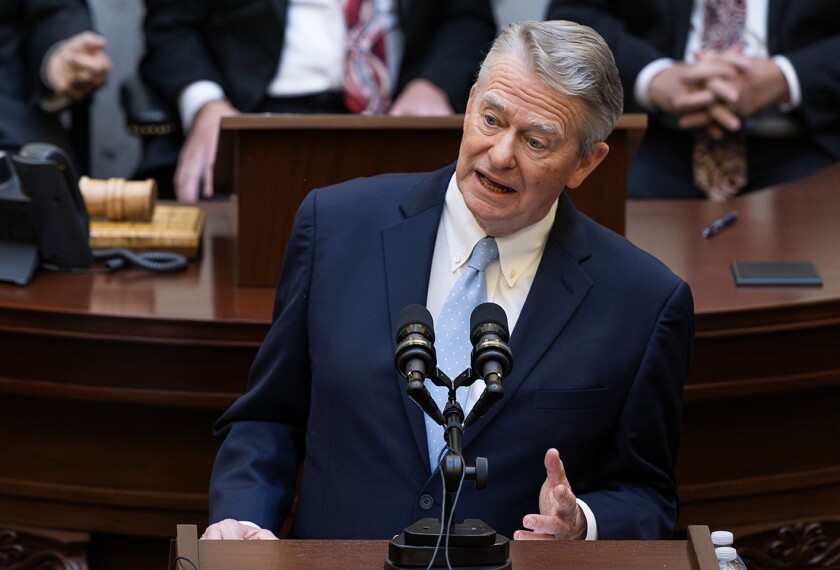Nevada voters could be drawn into an all-out battle to decide how big a priority school funding should be if two initiatives to amend the state constitution find their way to the ballot. One initiative, proposed by the Nevada State Education Association, would require state lawmakers to increase per-pupil spending to the national average by 2012.
The 22,000-member teachers’ union, which filed its petition in February, will need the signatures of nearly 52,000 registered voters in order to put the proposal on the November ballot.
In order for the initiative to become law, it will need the approval of more than 50 percent of voters in each of two election years.
If approved, union officials say, the measure would provide the state’s rapidly expanding student population with better educational opportunities by ensuring smaller class sizes, better technology, and adequate textbooks.
But opponents say the NSEA initiative is not viable because it doesn’t adequately define what “national average” means and doesn’t provide a mechanism for funding the proposal.
Competing Plans
U.S. Rep. Jim Gibbons, R-Nev., and his wife, Assemblywoman Dawn Gibbons, also a Republican, have proposed an alternative initiative called Education First. Their proposed amendment was spurred by last year’s extended legislative session, which some claim held education funding hostage. (“Lawmakers’ Tussle Ripples Across Districts,” Capital Recap, Sept. 3, 2003.)
The proposal, which must clear the same legal hurdles as the NSEA plan, would put the education budget on a par with other mandatory state budgets, such as those for the court and prison systems. Those services are required to have budgets passed by July 1 of each year in order for the state government to continue to function.
“Education should be funded just like other state services,” said Ms. Gibbons. “If it’s put on hold, it affects students.”
And it can affect them in a big way, she contends. The 2003 legislative fiasco sparked a bitter, 49- day battle between the two chambers of the legislature. It also prompted lawsuits, and forced districts to delay hiring and postpone the start of the new school year while administrators scrambled for operating funds.
“Morale was extremely low,” Clark County schools Superintendent Carlos Garcia commented in a July 2003 interview with Education Week. The 265,000- student district, which includes Las Vegas and serves 70 percent of the state’s student population, was so fearful that state funding would be cut off that school officials had begun to look into securing loans to run the district’s 275 schools.
Lawmakers finally agreed on a $836 million tax hike on July 22.
Union officials argue that there’s no point in funding education first if the state doesn’t have enough money. “The Education First initiative is basically political eyewash,” said Ken Lange, the NSEA’s executive director. “Unless you set a meaningful standard for education funding, when you pass the budget doesn’t matter.”
Although the K-12 budget may seem to be galloping forward because of a continually growing student population, he said, it has actually remained flat in terms of per-pupil spending.
Contrasting Costs
As a result, the needs of schools are not being met, Mr. Lange contends. Smaller class sizes, full-day kindergarten, and better salaries and benefits for teachers are matters the state must address to improve student achievement, he said. Currently, Nevada ranks 45th in the nation in per-pupil spending, averaging $5,800 in 2001-02. The national average for that school year was $7,500. Ms. Gibbons argues, however, that passing the union’s initiative without a funding mechanism could prove disastrous. “I looked into putting [the NSEA’s idea] into our petition,” she said. “But if you propose spending in our state, you also need to put in a mechanism for funding it.”
The union, she said, doesn’t have any means of paying for its plan. She said that meeting the national average in today’s dollars would cost taxpayers more than $400 million for the 2004-05 school year. Union officials say the total is more like $669 million.
By 2012, it would cost nearly $1 billion, said Ms. Gibbons. Union officials say the $1 billion price tag would come as soon as 2009.
But Mr. Lange says it’s a matter of priorities, not costs, and that lawmakers would have eight years to draft a fiscal plan: “It’s the legislature’s job to prescribe how to get there. That’s what they’re elected to do.”
Ms. Gibbons doesn’t dispute that priorities need to be set, but says voters and legislators should ask where the money will come from.
Still, she agrees with the union on one point: “If education isn’t funded first, it is always going to be funded last.”




